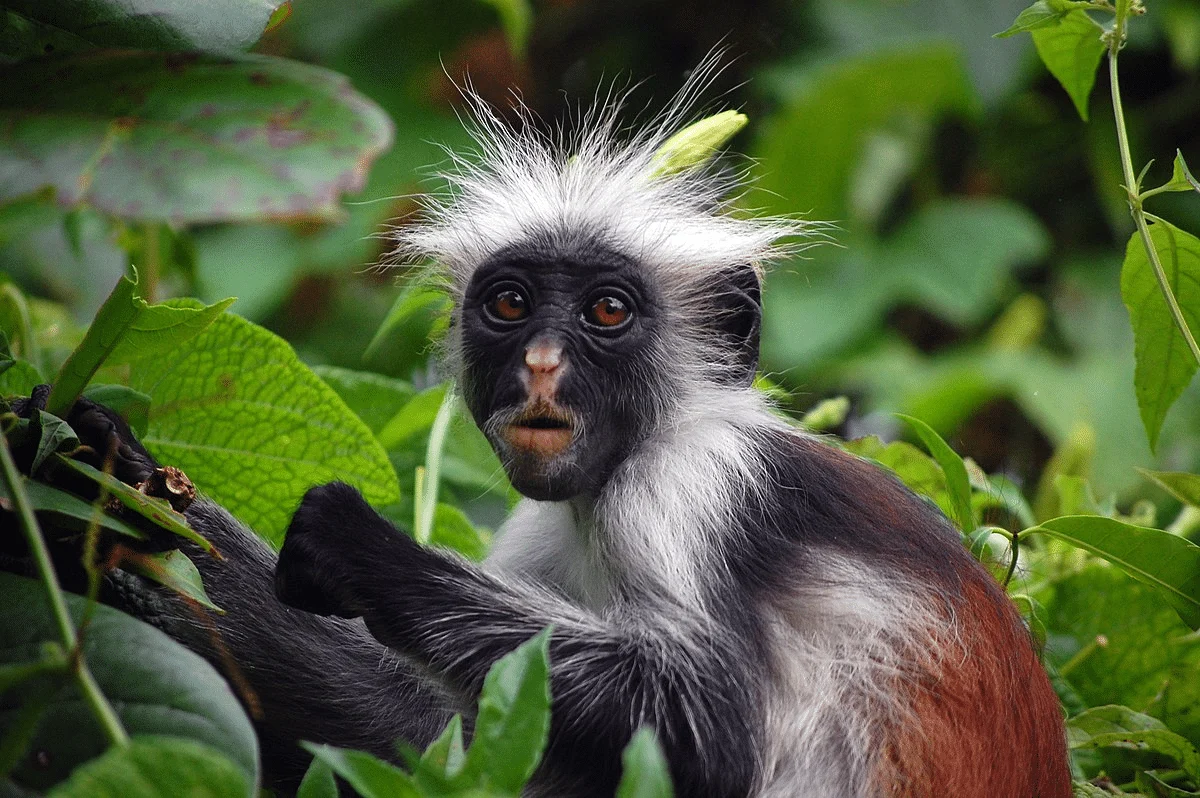Primates are the closest relatives to humans and are an essential part of the world’s biodiversity, undoubtedly contributing to keeping the global ecosystem healthy.
Unfortunately, approximately 75% of the primate species population is drastically declining, and 60% of the primate species are close to extinction.
In this article, we discuss the 21 most endangered primates published and selected by the Species Survival Commission, International Union for Conservation of Nature, Bristol Zoological Society, Global Wildlife Conservation, International Primatological Society, and Primate Specialist Group.
What Are Primates?

Primate is a group of mammals that includes monkeys, humans, tarsiers, apes, lorises, and lemurs. They are kept in separate groups because of their well-developed features, such as having complex brains and flat nails on their digits.
21 Most Endangered Primates

About 90 countries are home to different primate species, and they most commonly occur in mainland Africa, Neotropics, Asia, and Madagascar. But unfortunately, some of their species will lose the world as their home for various reasons, including unsustainable human activities.
1. Tana River Red Colobus

Scientific Name: Procolobus rufomitratus
Habitat: The red colobus lives near the Tana River situated in Northern Kenya.
Body: An adult Red colobus is 56cm long with a 80cm long tail and weighs around 8 kg.
Threats to Red Colobus: The leading cause of their population reduction is the rapidly increasing population of humans in the region and the construction of hydroelectric dams.
Due to the construction of dams, the vegetation of the tana river is changing. As a result, the ideal food for the red colobus is almost unavailable; therefore, they are starving and becoming endangered.
Another decisive factors of their endangerment are certain parasitic infections and hunting by humans.
Population: Less than 1000 red colobus remain, making them a critically endangered species.
Conservation Status: The Tana River red colobus is considered a highly endangered species.
2. Tapanuli Orangutan

Scientific Name: Pongo tapanuliensis
Habitat: This species of primates are most commonly seen in subtropical and tropical broadleaf forests on the island of Indonesia and Sumatra, and are restricted to the South Tapanuli.
Threats To Tapanuli Orangutan: This extremely rare great ape is becoming endangered because of specific threats that include:
- Illegal wildlife trade
- Hunting
- Habitat destruction
- Conflict with humans
- Mining
- Construction of proposed dams
- Hydropower project
Population: According to a 2018 IUCN report, only 800 individuals of Tapanuli orangutans still exist.
Conservation Status:
Currently, the Tapanuli Orangutan is on the list of critically endangered species.
Importance: The Orangutans are an essential species in the forest’s ecosystem for many reasons. One of the most common reasons for their importance is that they disperse seeds throughout the forest, creating an environment-friendly habitat.
3. Gaoligong Hoolock Gibbon
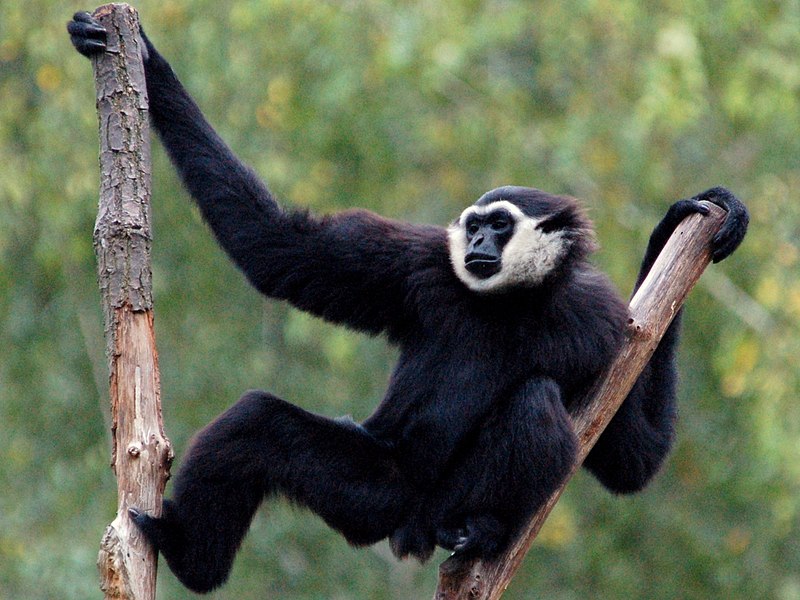
Scientific Name: Hoolock tian xing
Natural Territory: Mt. Gaoligong region of southwestern China and the mountain forests of eastern Myanmar are home to the Skywalker hoolock gibbon or Gaoligong hoolock gibbon.
Appearance: Skywalker hoolock gibbon adult males and females have different appearances. The adult Gaoligong Gibbon females are buffy brown and have light-coloured crowns, while the adult males are black. But their eyebrows are white, which is the diagnostic characteristic of this species.
Threats To Gaoligong Hoolock Gibbon: The different causes of their endangerment include:
- Illegal Hunting
- Deforestation
- Pet trade
- Habitat loss
Population: Less than 150 Gaoligong Hoolock Gibbon are left in the world.
Conservation Status: This primate species is included in the endangered species list.
Importance: Conservation of the Skywalker hoolock gibbon is crucial as it would also protect other biodiversity values.
4. Ecuadorian White-Fronted Capuchin

Scientific Name: Cebus aequatorialis
Habitat: As the Ecuadorian White-Fronted Capuchin has lost 90% of its total habitat, they are found only from western Ecuador to northwestern Peru.
Body: This primate is about 30 to 50 cm long and reaches full size when they become a grown adult. It weighs, on average, between 2.5 to 4 kg. Females are slightly smaller in size than males.
They have creamy hair and a pink face. This primate has large nostrils with flat noses.
Threats To Ecuadorian White-Fronted Capuchin: Cebus aequatorialis has faced various threats for many years, and now it is considered an endangered species. The most common threats to them are:
- Grazing
- Habitat fragmentation
- Illegal mining
- Anthropogenic factors
- Deforestation
Population: Only 300 individuals of Ecuadorian White-Fronted Capuchin are now living in the wild.
Conservation Status: Due to the rapid decline in the Ecuadorian Capuchin population, it is a critically endangered species.
5. Bemanasy Mouse Lemur
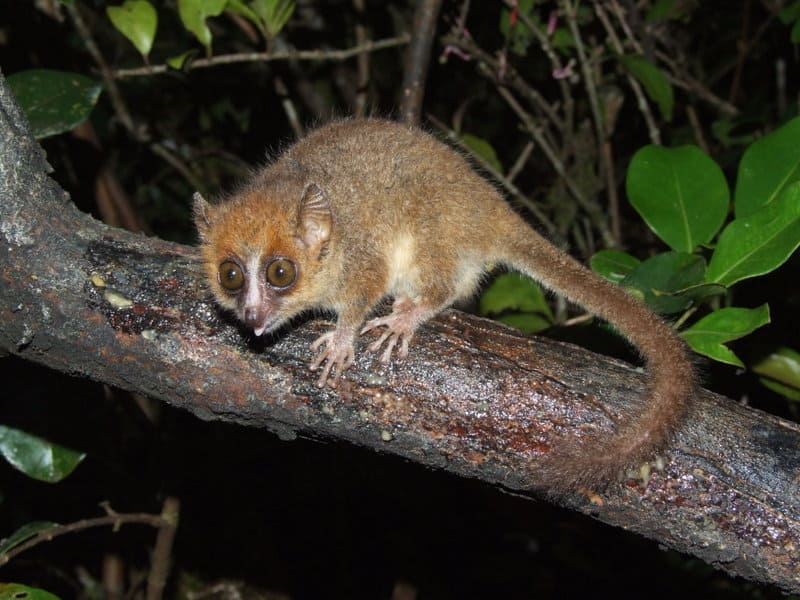
Scientific Name: Microcebus manitatra
Natural Territory: The Southeastern Madagascar forest fragment is home to the Bemanasy mouse lemur. It was discovered in 2016 as a separate species.
Physical Appearance: Among all the mouse lemurs, this species is somewhat larger. On their tail and back, a greyish-brown coat appears.
Threats to Bemanasy Mouse Lemur: Another primate that is becoming endangered with time is the Bemanasy Mouse Lemur, and the most common reasons for its population reduction are:
- Slash-and-burn agriculture
- Logging
Population: The remaining population of this species is very small although the exact number is unknown.
Conservation Status: It is a critically endangered primate and is near extinction.
6. James’ Sportive Lemur

Scientific Name: Lepilemur jamesorum
- James’ sportive lemur, also called Manombo sportive lemur.
Habitat: The manobo sportive lemur lives in southeastern Madagascar’s primary and secondary lowland forests.
Body: This lemur is counted among the largest sportive lemurs and is 60 to 67 cm long, of which 28 to 32cm is tail.
Threats: The threats that are continually face the James’ Sportive Lemur causing its endangerment are:
- Pet trade
- Habitat loss
- Hunting for bushmeat
Population: Less than 2000, about 1,386 Manombo sportive lemurs remain in the world.
Conservation Status: James’ Sportive Lemur is also a critically endangered primate, according to the IUCN report.
7. Lac Alaotra Bamboo Lemur

Scientific Name: Hapalemur alaotrensis
- Alternative names include: Alaotra reed lemur, Alaotran gentle lemur, Alaotran bamboo lemur, or Lac Alaotra mild lemur.
Habitat: This species of primates resides in northeast Madagascar around Lac Alaotra. It doesn’t eat bamboo and specifically lives in papyrus reeds.
Body: It usually appears in brownish-gray color and has a 40 cm long body and 40 cm long tail. It weighs between 1.1 and 1.4 kg.
Threats: The Alaotran gentle lemur has become critically endangered because of the following reasons:
- Hunting for pet trade and food
- Habitat destruction
- Burning marshland
Population: According to an estimation in 2018, the total population of the Lac Alaotra gentle lemur is 2,500.
Conservation Status: Unfortunately, this primate is also considered a critically endangered species by the International Union for Conservation of Nature.
8. Indri

Scientific Name: Indri indri
- Babakoto is the second name of Indri.
Habitat And Distribution: Madagascar is home to Indri. They don’t inhabit the Masoala Peninsula but reside in the mid-latitude rainforest and the primary and secondary lowlands of the eastern rainforest.
Physical Appearance: Indri has a white and black coat and weighs between 6 and 9 kg. It has a length of 64 to 72cm.
Threats:The reduction in Indri population is mainly because of:
- Fragmentation
- Habitat destruction
- Logging
- Illegal Hunting
Population: According to a report, this primate has a remaining population of between 1,000-9,000.
Conservation Status: Indri is rated as a critically endangered primate by the International Union for Conservation of Nature.
9. Hainan Gibbon
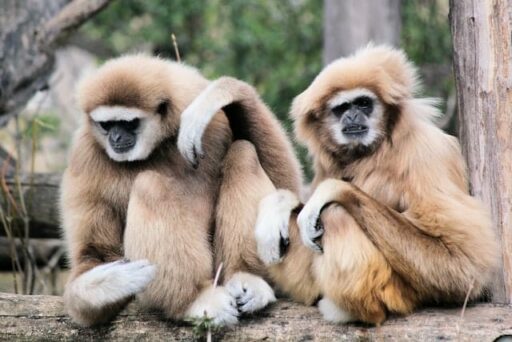
Scientific Name: Nomascus hainanus
- Hainan black-crested gibbon is another familiar name for Hainan gibbon
Habitat And Distribution: This primate only lives on Hainan island. Usually it inhabits semi-deciduous monsoon forests and broad-leaved forests.
Threats: The leading causes of the Hainan gibbon becoming endangered and threatened are:
- Hunting
- Habitat loss
- Pet trade
Population: The remaining population of the Hainan black-crested gibbons is only 30 individuals. Therefore it is not only considered the world’s rarest ape, but also the rarest mammal.
Conservation Status: Hainan gibbons are critically endangered primates.
10. Northern Sportive Lemurs

Scientific Name: Lepilemur septentrionalis
- Northern sportive lemurs are also famous as northern weasel lemurs or Sahafary sportive lemurs.
Habitat And Distribution: Northern sportive lemurs are native to Northern Madagascar. The natural territory of this primate is small areas of deciduous forests north of the Irodo River, in the immediate vicinity of Andrahona and close to villages of Ankarongana and Madirobe in the Sahafary region.
Threats: The most common threats to the Northern sportive lemurs are:
- Natural Habitat loss
- Illegal Hunting
Population: The remaining individuals of the Sahafary sportive lemur are only 50 to 70.
Conservation Status: The IUCN red list reported the northern weasel lemur as a critically endangered species.
11. Red Colobus Monkeys

Scientific Name: Piliocolobus
Habitat and Distribution: This primate is commonly distributed as allo- or parapatric and is native to eastern, central, and southern Africa. It is either arboreal or sometimes likes to live in the coastal thickets and scrub.
Threats: Red colobus monkeys are most commonly threatened due to the following reasons.
- Natural territory destruction
- Hunting
Population: The remaining population of red colobus monkeys is 3290- 4400 individuals.
Conservation Status: Out of 18 types, 14 red colobus monkeys are critically endangered, according to the IUCN red list.
12. Caquetá Titi Monkey

Scientific Name: Plecturocebus caquetensis
- Other names for the Caquetá titi monkey are bushy-bearded titi or red-bearded titi.
Habitat: The bushy-bearded titi occurs in the Department of Caquetá region in Columbia. Humid and hot rainforests are the ideal home for the Caquetá titi monkeys.
Threats: The main threat that is leading to the decline in the population of red-bearded titi is habitat destruction.
Population: Less than 250 adult Caquetá titi monkeys are alive, and thus there is an excellent need to conserve this primate; otherwise, it will become extinct in the coming years.
Conservation Status: IUCN classified it as a critically endangered primate.
13. Gray-Shanked Douc Langur
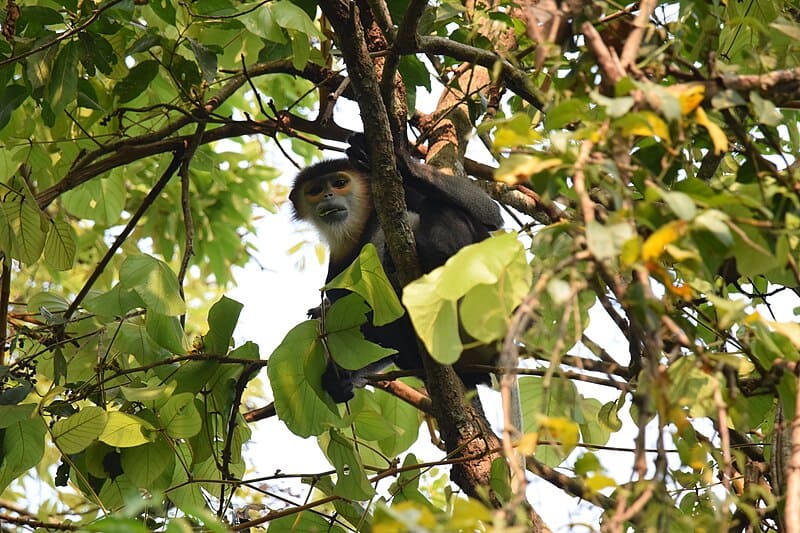
Scientific Name: Pygathrix cinerea
Distribution and Habitat: Grey-shanked douc is native to the Quảng Ngãi, Quảng Nam, Kon Tum, Bình Định, and Gia Lai Vietnamese provinces.
Threats: Natural territory loss and hunting are the major threats to Pygathrix cinerea primates.
Population: The population of Gray-Shanked Douc in 2004 was about 550 to 700 individuals, but in 2016 it was reported that their population had increased to 1000.
Conservation Status: Gray-Shanked Douc Langur is also a critically endangered primate.
14. Tonkin Snub-Nosed Monkey

Scientific Name: Rhinopithecus avunculus
- Tonkin snub-nosed monkey is also called Dollman’s snub-nosed monkey
Natural Territory: Among the karst limestone, isolated forest fragments of northern Vietnam are home to the Tonkin snub-nosed monkey.
Threats: Like all the other primates, this primate is also suffering a reduction in population due to
- Hunting
- Habitat loss
- Fragmentation
Population: Only 200 to 250 individuals of Dollman’s snub-nosed monkey are left worldwide.
Conservation Status: It is among the critically endangered primates list of IUCN.
15. Golden-Headed Langur
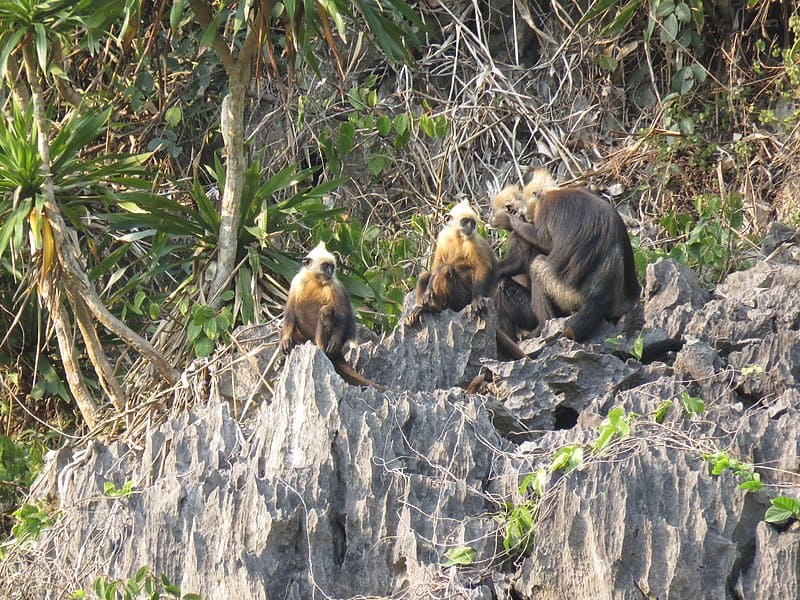
Scientific Name: Trachypithecus poliocephalus
- The golden-headed langur is another common name for Golden-headed langur
Distribution And Habitat: Golden-headed langurs are widely distributed in the limestone forests of Cát Bà Island, Northern Vietnam.
Threats: Specific threats that led to the high reduction in the overall number of Cat Ba langur are:
- Hunting
- Habitat fragmentation, such as development for tourism and human encroachment
Population: Unfortunately, less than 70 individuals of this unique primate, the Golden-headed langur, are left worldwide.
Conservation Status: The golden-headed langur is on the threatened species list of IUCN.
16. Aye-aye
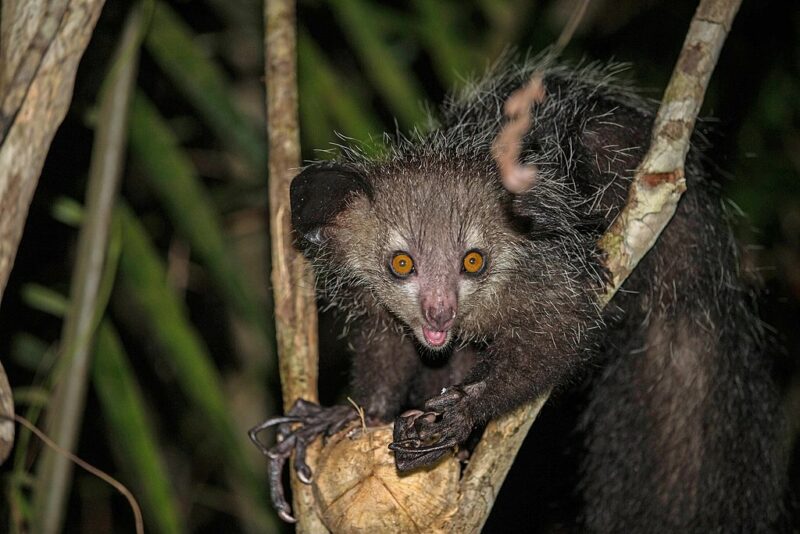
Scientific Name: Daubentonia madagascariensis
Habitat: Madagascar is home to the Aye-aye primate.
Threats: The most common causes of the aye-aye becoming endangered are:
- Continued growth of the human population
- Hunting
- Habitat destruction
- Destruction of rainforests
Population: The number of aye-aye individuals is about 1,000 to 10,000 worldwide and is not considered critically endangered.
Conservation Status: The IUCN has listed aye-aye as an endangered primate.
Fact: Aye-aye is the largest nocturnal primate on our planet.
17. Rondo Dwarf Galago
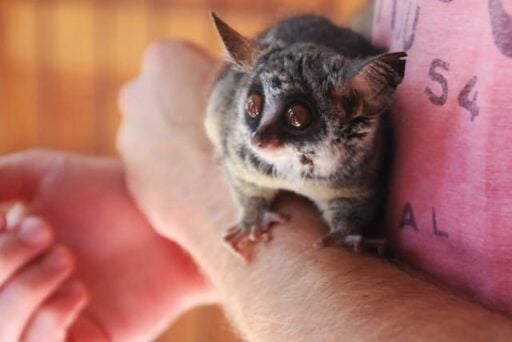
Scientific Name: Paragalago rondoensis
- Another common name for the Rondo dwarf galago is Rondo bushbaby.
Habitat and Distribution: The tropical or subtropical coastal dry forests of Tanzania and the surroundings of Dar es Salam are the native regions of the Rondo dwarf galago.
Threats: The main threats faced by the Rondo bushbaby are:
- Hunting
- Loss of natural home due to logging
Population: The exact number of living Rondo bushbaby population is unknown yet, but it is decreasing with time.
Conservation Status: It is counted among the endangered primates of the world.
18. Roloway Monkey
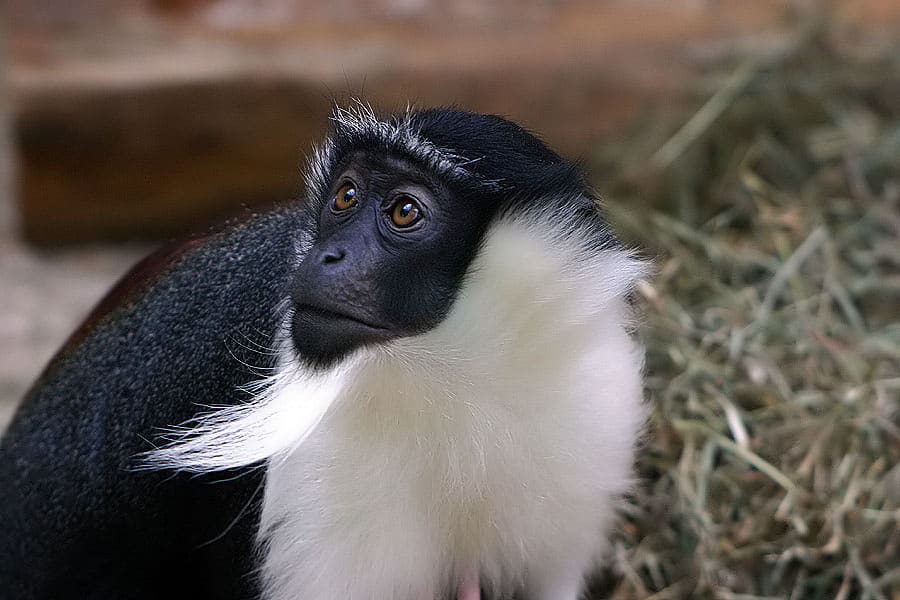
Scientific Name: Cercopithecus roloway
Habitat: The Roloway monkey is native to tropical West Africa. It occurs in Togo, Burkina Faso, Ghana forests, and the eastern ivory coast.
The natural habitat of the Roloway monkey is considered complex because they have multiple places to escape, view and hide.
Threats: The loss of natural territory and hunting are the main reasons for their reduction on our planet.
Population: The population of Roloway monkeys is merely 300 because the environment is badly affecting it.
Conservation Status: The rollaway monkey is a critically endangered primate.
19. Eastern Black Crested Gibbon
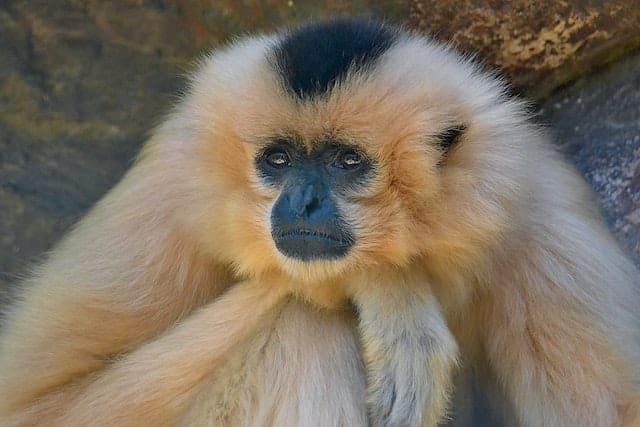
Scientific Name: Nomascus nasutus
- Cao-vit crested gibbon or Cao-vit black crested gibbon are other common names of the Eastern black crested gibbon.
Habitat and Distribution: Eastern black crested gibbons most commonly occur in Northern Vietnam and southeast china. It favors mountainous areas and deciduous forests, semi-evergreen and evergreen forests of the subtropical region.
Threats: Sadly, the causes due to which the Cao-Vit crested gibbon became critically endangered are:
- Deforestation
- Poaching
- Encroachment
Population: Less than 250 mature Eastern black crested gibbons remain.
Conservation Status: It is also a critically endangered primate which means it is one of the rarest species.
20. Greater Bamboo Lemur
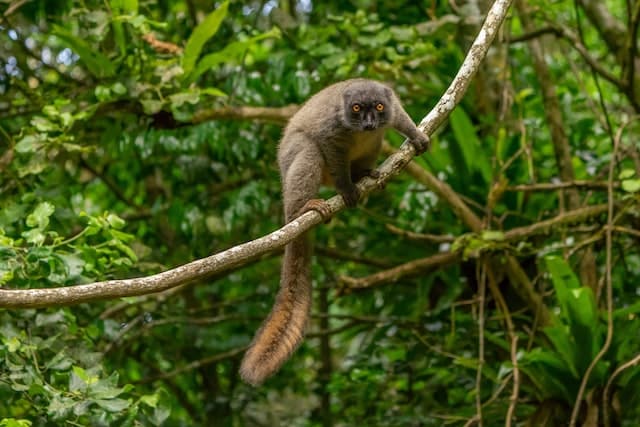
Scientific Name: Prolemur simus
- Other common names for Greater bamboo lemur include: broad-nosed gentle lemur and broad-nosed bamboo lemur.
Habitat: The island of southeastern Madagascar is home to the Greater bamboo lemur.
Threats: The greater bamboo lemur significantly reduced in number because of the;
- Deforestation
- Slash-and-burn agriculture
- Effects of climate change on the Greater bamboo lemur’s teeth are also considered a safe reason for their population reduction by scientists.
Population: 100 to 160 broad-nosed bamboo lemurs remain in their native regions, and 20 in captivity.
Conservation Status: The broad-nosed gentle lemur is among the endangered primates continuously reducing in number.
21. Perrier’s Sifaka

Scientific Name: Propithecus perrieri
Habitat And Distribution: Perrier’s sifaka is endemic to Madagascar. Specifically, they inhabit the semi humid or dry deciduous forests in the northeast part of Madagascar.
Threats: Fragmentation and habitat destruction due to logging, charcoal gathering, and slash and burn are the main reasons that Perrier’s sifaka became a critically endangered primate.
Population: Only 500 individuals of the Perrier’s sifaka remain in the world.
Conservation Status: According to an IUCN report, the Perrier’s sifaka is critically endangered.
Wrapping Up:
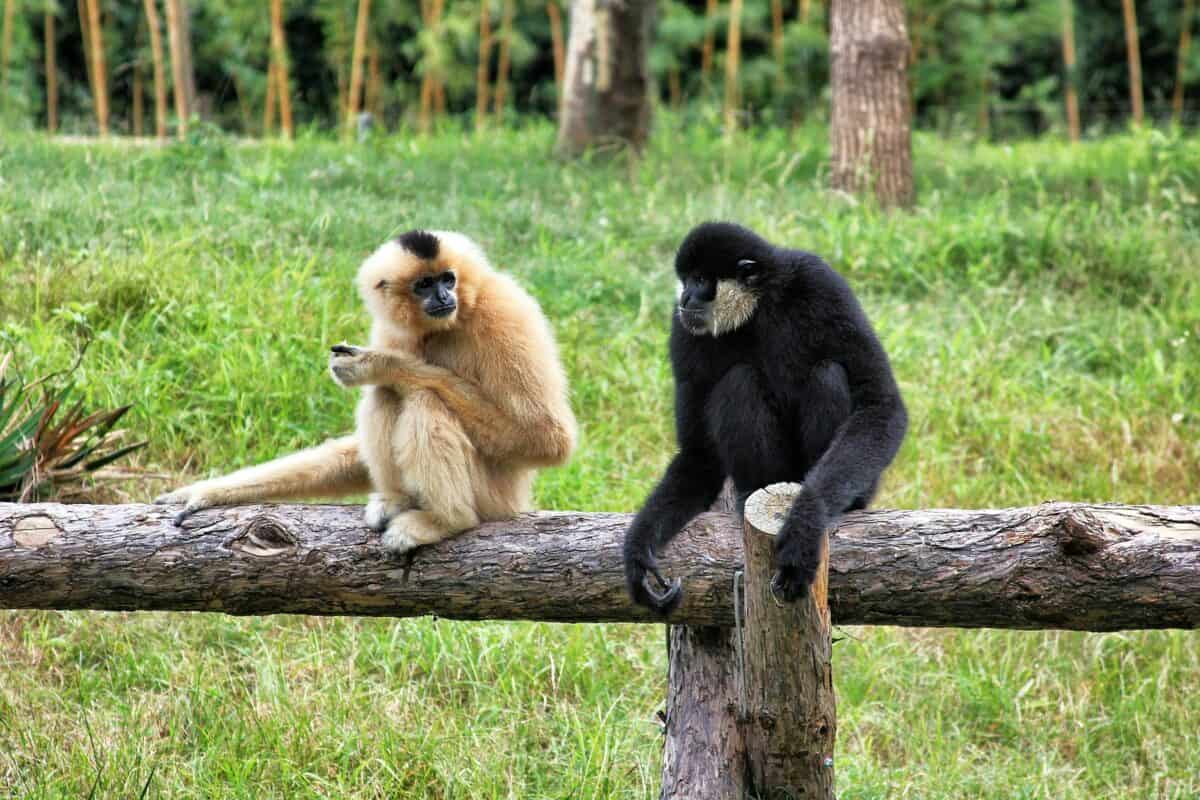
With the increasing human population, deforestation, construction, and hunting, our planet is becoming unfavorable for many species of animals, including primates.
In this article, we have uncovered the 21 Most Endangered Primates. Conservation of primates is the only way to increase the population of primates.
Thank you for reading this article! If you have not had enough monkey business you should read about the tiniest and cuties monkey called Finger Monkeys.
Frequently asked Questions (FAQs)
Yes, there are several endangered primate species. Notably, factors such as habitat loss, deforestation, illegal hunting, and human-wildlife conflict contribute to the endangerment of various primate species worldwide
The endangered largest primate is the Eastern Gorilla (Gorilla beringei), specifically the Mountain Gorilla subspecies (Gorilla beringei beringei). These gorillas are primarily found in the mountainous regions of Central Africa.
Several primates are endangered, impacting the field of anthropology and biodiversity conservation. Some notable endangered primates include the Tapanuli Orangutan, Hainan Gibbon, and the Indri. The conservation of these species is crucial for maintaining biodiversity and understanding our evolutionary history.
The greatest threats to endangered primates include:Habitat Loss: Deforestation and destruction of natural habitats due to agriculture, logging, and urbanization.
Illegal Hunting: Poaching for bushmeat, traditional medicine, and the pet trade.
Human-Wildlife Conflict: Encroachment on primate habitats leading to conflicts with humans.
Climate Change: Altered weather patterns affecting primate habitats and food sources.
Join our Forum for free today!


